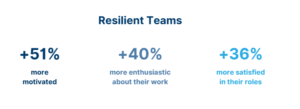
GCG Leadership Development Team
What is resilience?
We’ve established that resilience is of the utmost importance for strong leadership. It’s certainly the most pervasive topic in the media around how organizations can withstand the effects of the pandemic. But, what is it? Sure, we could call it endurance, perseverance, or intestinal fortitude. We could even compare it to rubber bands, plant root structures, or an object’s buoyancy. Ultimately, we believe the simplest way to think about it is that resilience is the ability to continue operating effectively, as normal, in the face of disruptive changes and difficult circumstances. This doesn’t mean that leaders ignore problems or pretend that everything is fine. But rather that they’ve developed the ability to adapt to their changed circumstances well enough so that the results remain unchanged.
Why is resilience so important in leadership?
There are many common pitfalls and misconceptions that leaders are prone to. The one that COVID seems to have highlighted the most is the idea that leaders are invincible titans, rather than the human beings we know them to be. In the same way that airline emergency procedures instruct passengers to put on their own oxygen mask before helping others, it’s essential that leaders strengthen themselves so that they are properly equipped to be an actual help to the people relying on them. After all, every good leader holds their team together. Without them, the entire team will inevitably fall apart.
To that end, we’re not going to teach you the innumerable ways you can build a resilient team. We’re going to encourage you to focus on yourself for starters. Master building up your own resilience first and the team you lead will immediately have a headstart on their journey to becoming resilient themselves. Your actions are the example set for your team. They will mirror your attitude, approach, and results.
When a leader allows their external circumstances to dictate how they handle any given situation they’re not acting, but rather reacting. When leaders are primarily reactive, they’re in a fragile state and much more likely to take a brash, uncalculated, ill-advised, or indecisive course of action. That’s not strong leadership. That’s not taking care of the team. In the end it’s short-sighted, selfish, and ineffective which is detrimental because they’re not based on the needs and goals of the organization. Sadly, these effects ripple out to your team and beyond.

But does any of this translate into tangible improvements, or is it all just theory? Well, research shows that resilient teams are 51% more motivated, 40% more enthusiastic about their work, and 36% more satisfied in their roles than those that are less resilient. That’s not the end of the good news either. Resilient teams are also 35% more energetic, have 30% lower turnover intentions (an individual’s intention to voluntarily quit an organization or profession), and are 26% more confident in their work. In short, resilient leaders uniquely empower their teams in ways with direct potential to have a domino effect throughout the entire organization.
How do we develop leadership resilience?
So where and how does all of this begin, especially in the midst of what feels like exceptional circumstances? After all, COVID has teams and leaders emotionally exhausted, lacking in productivity, and nervous in the face of an uncertain future. It’s tempting for leaders to cut corners when it comes to taking care of themselves, in their efforts to care for their team during a crisis. But this undermines their own resilience and thus opens up the entire organization to a potentially devastating ripple effect, especially if more than one leader falters during the same period. That’s why leaders looking to develop resilience must start with themselves and trust that, in doing so, they’re modelling resilience-building behaviors that will inspire their teams and their peers.
The first step in developing leadership resilience is establishing what it means to you in the first place. If you have unhealthy and unhelpful ideas around what resilience is then you won’t get very far. Likewise, if you lack the self awareness to know where the limits of your resilience lie then you’re in dangerous territory. So do whatever it takes to orient your approach and habits around an accurate understanding of what leadership resilience looks like in light of your personal limits and unique context.
Once you’re confident you’ve got a firm grasp on what leadership resilience looks like, and where your limits are, you should aim to implement structures that help you pursue development and avoid overextending yourself. This is what is often referred to as choice architecture; putting measures in place that make it easier for you to take the actions you desire and more difficult to take the actions you’d like to avoid. While the application of this will be different for every leader, we have noticed a number of common methods that pop up.
First, focus on the positive. If you’re overwhelmed by the barrage of difficulties coming your way, start by taking a breather. Limit how much time you spend on activities that disproportionately sap your energy, or rearrange your daily tasks into chunks of similar work at certain times of the day. That way they compliment your natural energy rhythms rather than work against them.
Next, eliminate the negative. This means establishing boundaries for your work/life balance so that you avoid developing toxic habits, cutting out unhealthy crutches (over-reliance on caffeine, processed foods, and late-night work that ruins your sleep), and redirecting your attention when you start to spiral into negativity or procrastination.
Finally, be open about your journey. By sharing your successes and failures with your peers, and your team, you not only model resilience building behaviors but you also provide your own experiences as a case study for others to learn from. So offer up your self-care strategies, share your vulnerabilities, and always remember that everyone deals with difficult situations in different ways. You need to allow room for your team to take what is helpful for them, from your journey, and to leave the rest behind in favor of what works for their development.
Ultimately, resilient leaders are not thermometers simply showing what is around them in their organizations, but thermostats setting the tone that others follow.
Leadership coaching is a natural fit for anyone looking to build resilience. Even the most self-aware leader benefits from getting an outside perspective on their strengths and areas to develop . No matter how driven a leader is, without accountability progress will always be in question. And confident leaders still benefit from the reassurance, encouragement, and guidance of someone who has travelled down this path before. Learn more about our leadership coaching programs here or download the Leadership Coaching for Professionals brochure here.
If you are a leadership coach looking to become a part of the world’s largest leadership coaching organization with ICF accredited certifications, click here or download the Coach Certification Program brochure here.

GCG Leadership Development Team
Learn about the GCG's Coaching Tools
Measurable results, in LESS Time.
Reduce your session prep and follow-ups to just 15 minutes, while delivering coaching that improves leadership, team and business performances with 95% coworker satisfaction
